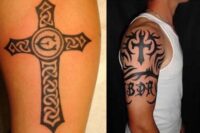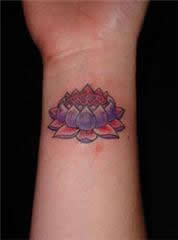
Eyes of friends and strangers alike immediately fall to the arm, the shoulder, the back, or perhaps even to the unnaturally elongated earlobe — sometimes a question follows, sometimes it doesn’t.
The tattooed and the pierced have signed up for it all, deeming a stamp of meaning or originality worth the cost, the pain, the permanence, and the perpetual need to cover their artwork for job interviews. As tattoo shops spring up in suburbia and tattoos become standard fare in offices, researchers and industry professionals are finding many willing to go under the needle do so in the name of some expression of spirituality. In many other instances, they do so in the name of their own personal philosophy of faith.
“Anecdotally, yes, it seems more and more people are becoming modified: tattooed, scarred, and pierced,” says Jaime Wright, who completed a master’s thesis in 2006 on the topic of religion and body modification, while studying at the Graduate Theological Union. He notes the presence of TV shows such as “Miami Ink” and “One Punk Under God,” a show featuring the Generation X preacher son of Jim and Tammy Faye Bakker Jay, who donned tattoos and a subcultural style to better connect with a younger generation.
Tattooing has a storied history ranging from early scarring – cuts rubbed with herbs and ash – that were found on Ötzi the Iceman whose body dates back possibly to 3300 BCE, to simple designs popularized by military men who boasted a love of God, country, and buxom blondes on their biceps, according to Wright. There is still a prevalence of religious emblems — the most obvious being crosses and rosaries — popular among the tattooed, but tattooing and the permanence thereof often allows people to redefine themselves and their spirituality on their own terms.
Clearly, not everyone who decides on a tattoo does so for religious reasons. But findings from a research group at Texas Tech University appear to back up the theory that among college-age students who go under the needle, religious emblems are common choices for their artwork. In the early 200s, Dr. Jerome Koch, who has a Master’s Degree in Divinity and teaches sociology at Texas Tech, delved into the topic of body modification and how it relates to deviance with a research team comprising himself, Alden Roberts, Myrna Armstrong and Donna Owen, all TTU professors. Their initial findings were presented at the annual meeting of the Religious Research Association in Nov. 2007, in Tampa, Fla.
“Though clearly not everyone who decides on a tattoo does so for religious reasons, findings from a research group at Texas Tech University appears to back up the theory that many do.”
Findings from the group’s 2004 and 2005 studies both found that religiousness did not have much of an impact on people’s desire to get a tattoo or piercing. Later, in the group’s ongoing study, “Religiosity, Fundamentalism, Deviance and Body Art,” Koch and his group measured “religiosity” by asking college-age students from four different campuses about churchgoing habits, amount of prayer and Bible reading, among other things. The study sample was roughly 1,700 students large, equally divided among two religious schools, Baylor University and the University of Notre Dame, and two state schools, Texas Tech and Purdue University, Koch said.
The group found that people with tattoos and piercings had religiosity scores that were roughly 10% lower than those without body art. These findings suggest that people with tattoos and piercings were roughly eight to 10% less religious than their peers, Koch said.
Still, 44% of tattoos at Baylor were religious symbols. At Texas Tech, a non-religious school, only 28% were religious in nature, Koch said. These findings suggest that religion itself doesn’t necessarily play into the decision-making process of getting a tattoo. But religious students — at Baylor and Notre Dame — found tattooing a good way to express their religiosity.
“These tattoos are symbols that suggest they’re going to be religious their whole life — that religion is a permanent part of their identities,” Koch said. “Sometimes they’re memorials, sometimes they’re reminders of faith.”
Religious tattoos were memorials of deceased family or friends, permanent reminders of personal faith, or signs of commitment, according to the study. One male student, 19, said it reminds him “that God is always with me, no matter what.” One female student and Sunday school teacher, 20, said the cross on her right foot reinforces her “very strong” Catholic faith.
“Basically, we cobble together our identities, and so do people with tattoos cobble together various points of relation and meaning with their tattoos,” said Wright, who is currently in a Ph.D. program in Ethics and Social Theory, a cooperative program between the Graduate Theological Union and UC Berkeley.
Wright, in his research, has found that in Generation X and post-Generation-X forms of religiosity, two things are emphasized: ancient tradition and intensity. Whether some practice is legitimized through Christian groups or body modification groups, tying practices to something ancient and, therefore, somehow more authentic, is key. Often, religion and spirituality can play a large part in this legitimizing process
“There is also a contingent who get modified to go against the grain of mainstream body aesthetics or get a tattoo simply because they like the work of the tattoo artist,” Wright acknowledged. “So, I don’t want to imply that for everyone getting modified it is quasi-religious, but it seems to be for many.”
Creating meaning and identity with a tattoo, however, can pose a problem for some who believe that tattoos are a slap in the face of their faith. Many cite a biblical passage, Leviticus 19:28, that says “Ye shall not make any cuttings in your flesh for the dead, nor print any marks upon you.” On Hillel.org, in fact, as well as many other blogs and websites dedicated to Jewish faith, many express concern that a tattoo would effectively ban them from proper burial in a Jewish cemetery.
Of course, the added symbolism behind tattoos can be appalling to Jews. To a younger generation, tattoos are symbols of individuality or celebrations of commitment to their faith. To an older generation, tattoos are, conversely, symbols of oppression and being persecuted because of their faith.
 There is still a heightened desire to redefine spirituality or faith with ink. The Rev. Giotto Harrison, a self-professed theosophist and tattoo artist at Sacred Rose Tattoo in Berkeley, Ca., agrees that more people are getting tattoos these days; but he notes that people have always been getting tattoos. The difference now is that many dogmas associated with tattooing are breaking down, as the desire for people to feel unique in a homogenized world increases.
There is still a heightened desire to redefine spirituality or faith with ink. The Rev. Giotto Harrison, a self-professed theosophist and tattoo artist at Sacred Rose Tattoo in Berkeley, Ca., agrees that more people are getting tattoos these days; but he notes that people have always been getting tattoos. The difference now is that many dogmas associated with tattooing are breaking down, as the desire for people to feel unique in a homogenized world increases.
 “Tattoos allow a chance to be unique or at least have expression,” Harrison said. “It is still, at times, a mark of rebellion, but most people these days are getting tattoos to make a statement about the person they are, to embrace that and validate who they are, to themselves, for themselves.”
“Tattoos allow a chance to be unique or at least have expression,” Harrison said. “It is still, at times, a mark of rebellion, but most people these days are getting tattoos to make a statement about the person they are, to embrace that and validate who they are, to themselves, for themselves.”
The positive nature of the tattoo is perhaps the biggest change in what tattoos represent, Harrison said. Tattoos, as Wright said, have been used as marks of triumph or passage. Harrison adds some also had overtly “anti” associations. Now, however, Harrison says more tattoos than ever are about light, love, beauty and other positive associations – things many religions and individual spiritual paths seek to encourage.
“It is still, at times, a mark of rebellion, but most people these days are getting tattoos to make a statement about the person they are, to embrace that and validate who they are, to themselves, for themselves.”
 Tattoos can be as generally spiritual as marking a certain event, awakening or realization for people, so they continue to acknowledge that epiphany and remain aware, Harrison said. Remaining aware was key for San Francisco resident Dana Kilian, who has two tattoos – the most recent of which was her more spiritual one. This tattoo, a cherry blossom on her left forearm, represents rebirth and hope, she said. It’s on the same side as her wedding ring, another, more familiar symbol of an individual, long-term commitment.
Tattoos can be as generally spiritual as marking a certain event, awakening or realization for people, so they continue to acknowledge that epiphany and remain aware, Harrison said. Remaining aware was key for San Francisco resident Dana Kilian, who has two tattoos – the most recent of which was her more spiritual one. This tattoo, a cherry blossom on her left forearm, represents rebirth and hope, she said. It’s on the same side as her wedding ring, another, more familiar symbol of an individual, long-term commitment.
“(It) also reminds me – daily, whenever I look at it — to be true to my sense of style, personality and values,” said Kilian, who identifies herself as spiritual and not religious.
Tattoos can also be as overtly religious as Rocks of Ages tattoos – a topic on which tattoo artist Don Ed Hardy wrote a book popular among tattoo artists and enthusiasts, Harrison said. The Rock of Ages is a popular symbol in Christianity, depicting a soul lost in the sea of life, or sin, and clinging to the Rocks of Ages, or Cross of Christ.
In practice, Harrison finds familial and memorial tattoos are more common than religious tattoos, which, according to the Texas Tech study, can also be religious or spiritual in nature. “Spiritual” tattoos, he says, far outweigh overtly “religious” tattoos such as crosses, noting he personally only does a small percentage of these religious emblems.
That said, the meaning of tattoos can be difficult to surmise without getting too personal, Harrison said. His job, he says, is simply to achieve the message and artistic relevance the client is looking for, which doesn’t always involve inquiring into the tattoo’s meaning.
 Discussion into the meaning and symbolism behind Valencia resident Jeanette Conery’s tattoo, however, was necessary. In fact, the design process itself took six months. Conery’s second and most recent tattoo is a colorful, Buddhist-inspired creation featuring Kanji for Nam Myo Ho Renge Kyo, a Buddhist chant. The chant means devotion to the mystic law of the Lotus Sutra. Though there are many different meanings and interpretations of the law, most important to Conery is the implicit eternity of all life through its latent and active stages.
Discussion into the meaning and symbolism behind Valencia resident Jeanette Conery’s tattoo, however, was necessary. In fact, the design process itself took six months. Conery’s second and most recent tattoo is a colorful, Buddhist-inspired creation featuring Kanji for Nam Myo Ho Renge Kyo, a Buddhist chant. The chant means devotion to the mystic law of the Lotus Sutra. Though there are many different meanings and interpretations of the law, most important to Conery is the implicit eternity of all life through its latent and active stages.
Conery found the concept of a tattoo appealing, partially for artistic value, but also for the uniqueness and still-rebellious nature of them, she said.
The chant itself is something she does regularly, in addition to incorporating the message of the chant into her life.
“I try to have an attitude about life that reflects the values that this phrase embodies,” Conery said. “In other words, death is not to be feared because it’s just another beautiful part of life, and not being too attached to material possessions.”
As for her position on the religious/spirituality continuum, Conery says she is, “not very religious. Somewhat spiritual. I definitely have beliefs that nobody can change.”
This article was originally published in Busted Halo on April 16, 2008.




